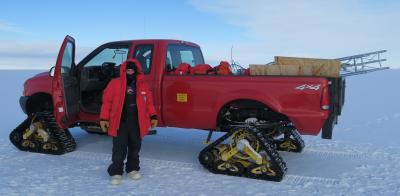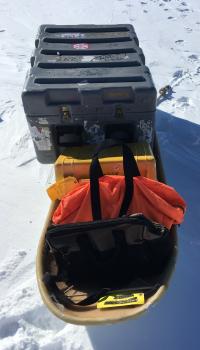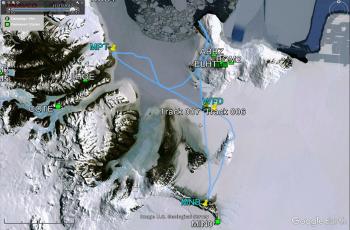Formal Introduction
My name is George Hademenos and I am a physics teacher currently in my 17th year at Richardson High School in Richardson, TX. My primary instructional mission as an educator is to ensure that not only are my students exposed to the knowledge, content and lab experiences consistent with a science course, but that they are also afforded the opportunity and presented with the challenges to develop and sharpen their critical inquiry, thinking, and reasoning skills – skills that are directly related and exclusively linked to a 21st century of invention and innovation. I constantly strive to incorporate and integrate these strategies to: 
PolarTREC Expedition
I was chosen to be part of the 2017 – 2018 cohort of PolarTREC teachers by Carol Costanza and Dr. Matthew Lazzara from the University of Wisconsin at Madison Space Science and Engineering Center (SSEC) to work on the Antarctic Automatic Weather Station project. Automatic Weather Stations (AWS) are free-standing structures equipped with mounted sensors that collect meteorological data on a consistent basis. The University of Wisconsin at Madison currently manages approximately 60 AWS located across Antarctica.
An Introduction to Automatic Weather Stations
The AWS group is responsible for the development, construction, assembly, and data analysis of approximately 60 AWS units positioned across the continent. An AWS is a free-standing structure with attached sensors designed to collect data representing the following weather variables: temperature, air pressure, relative humidity, wind speed and direction, and depth of snow accumulation. The collected sensor data from an AWS is stored and transmitted to Madison, Wisconsin for data analysis.
STEM Experience with Automatic Weather Stations
My STEM Experience was clearly described in a journal entry posted November 23 entitled, “Wishin and Hopin (and Liftin and Totin),” and a condensed summary of that posting follows. 
Up until Tuesday, November 21, one visit was made via helicopter to Lorne AWS where several items were on the itinerary upon reaching Lorne, but we had run into issues with the first task of extracting the battery box which had been sealed within its ice trench by a layer of ice on the bottom surface of the box. We had neither the tools nor the manpower to separate the battery box from the layer of ice and extract the battery box. Interestingly enough, on Saturday, November 18, we were placed on the helicopter schedule for a return flight to Lorne AWS, this time securing the necessary tools to handle the ice and recruiting two boondogglers (members from the community who volunteer their time and effort to help the scientists on their various expeditions). 
Yes, everything looked grim and glum…until yesterday! We finally got our opportunity to make great strides in our to-do list in the field. So, what I would like to do is take time in this journal post to talk about AWS units – one that we are erecting at Phoenix Field and four others (outside of Lorne AWS) that are established and have been transmitting correct data on a continual basis. Although each of these four AWS sites were on the plan for inspection, one AWS (Minna Bluff) was transmitting incorrect temperature and wind speed data, and we wanted to see what the problem was. I will be showing photos of each of the AWS units, including Minna Bluff, so you can see exactly why we were having problems with the data. At this point, I have had the opportunity to observe and become involved in various aspects of the AWS on various dates. In this journal, I would like to compile and discuss my observations with the AWS – starting from the beginning.
The Structural Framework of an AWS
The first stage in constructing an AWS in the structural framework consisting of a triangular tower that typically extends 10 – 20 feet from the ground. The tower comes in sections which can be attached, allowing the scientists to vary the height of the AWS according to the parameters 
On the date of the planned installation, all of the cargo required to construct an AWS 
Once the tower is constructed according to the planned height, the tower must be anchored in order to keep stabilized and upright for two reasons: (1) the tower with all of the sensors and attachments to the power supply must remain freestanding in order to continue collecting weather data under extreme weather conditions and, (2) the tower must be upright and aligned perpendicular as best as possible (using a level and line of sight) to ensure that any data dependent on orientation such as wind speed/direction be scientifically accurate. To accomplish this, the tower is stabilized by 3 guy wires (yes, it is spelled correctly), which are each anchored into an angled L-shaped bar called a deadman (again, it is spelled correctly), buried in a 2-foot trench, buried and packed with snow, as shown in the figure below.
Three deadmen (I believe that is the correct plural presentation of a deadman and not deadmans) are required to secure the three guy wires to support the AWS tower. Below is the final product of the AWS tower infrastructure.
Installation of the AWS Power Supply, Solar Panels and Sensors
Once the tower is erected, the next steps that follow are: mount the sensors at appropriate positions along the tower supporting rods; connect the sensors to a data logger that will collect and transmit the weather data obtained by the sensors; 
Of course, taking into account the sensors, the solar panel, the data logger control box, the antenna used to transmit the data from the data logger, 
Once the banana sleds have been pulled to the location of the AWS tower, everything must be unloaded, including the batteries. I then begin the process by liftin and then totin the battery (excuse the spelling – I am working within the theme of the journal post).
Carol donned her harness and began installing the sensors one by one, making sure that they were securely fastened to the tower supporting rods and that they were all level or perpendicular to the tower.
Maintenance and Repair of Functional/Operational AWS Units
As I mentioned in the introductory paragraph of this journal, the primary objective of my time in Antarctica was the opportunity to travel 
Future Plans Post Expedition
Upon completion of my expedition, I have already begun to map out a list of instructional activities to implement in the classroom and vehicles/platforms upon which to share my experiences with my teaching colleagues.
Instructional Activities for the Classroom
- An activity that I have already implemented in class which is entitled “Polar-ympics.” A description of this activity was detailed in a journal entry of October 30, Games People Play (https://www.polartrec.com/expeditions/antarctic-automatic-weather-stations/journals/2017-10-30)
- An activity that I have already implemented in class which is entitled, “Dressing the Part.” A description of this activity was detailed in a journal entry of October 30, You’ve Got a Friend (https://www.polartrec.com/expeditions/antarctic-automatic-weather-stations/journals/2017-10-30-0)
- I have an art student working on painting a ceiling tile to commemorate the Antarctica expedition.
- I am working to develop a children’s book illustrated by art students to convey the science experienced during the expedition.
- I am actively seeking grant opportunities to purchase an automatic weather station for my school to allow my students and environmental science students to explore and analyze weather data and compare them with data from Antarctica.
Vehicles/Platforms to Share with Teachers
- I have written an article on my experience for publication in the newsletter of the Science Teachers Association of Texas, STATellite.
- I have submitted an abstract to present observations of my PolarTREC experience at MiniCAST, a conference for science teachers who teach in the Dallas-Fort Worth Metroplex and surrounding school districts.
- I am currently drafting an article with three other PolarTREC teachers which will be submitted to a special issue of The Polar Record journal.
- I am working on a book that details my Antarctica expedition which I plan to share with my teacher colleagues.

| Attachment | Size |
|---|---|
| Download Report (996 KB)996 KB | 996 KB |
This program is supported by the National Science Foundation. Any opinions, findings, and conclusions or recommendations expressed by this program are those of the PIs and coordinating team, and do not necessarily reflect the views of the National Science Foundation.
